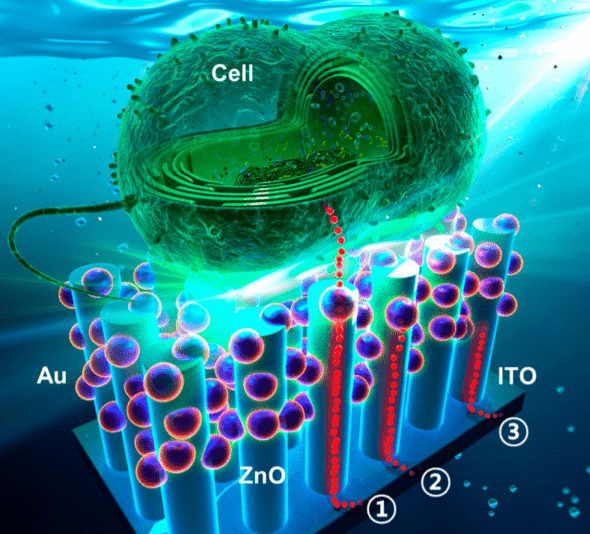
Strategically designed nanomaterials have been used to optimize the performance of a solar cell that incorporates photosynthesizing cyanobacteria. The work was done by Jae Ryoun Youn, Young Seok Song and colleagues at Seoul National University and Dankook University in South Korea. What is especially impressive about their new technology is that it exploits a broad region of the solar spectrum while simultaneously boosting the photosynthetic activity of the cyanobacteria.
The Sun offers a supply of clean and renewable energy, but how to utilize this limitless yet decentralized energy source as efficiently and practically as possible is a significant engineering challenge. The Korean team is pursuing a biological solution to this problem in cyanobacteria, which are ancient organisms that carry out photosynthesis and respiration in almost every environment on Earth.
Optimized biophotovoltaic cell
The device, described in Nano Letters, achieved enhanced efficiency by employing three separate active materials, each covering different regions of the solar spectrum.
Zinc oxide nanorods are highly photoactive in the ultraviolet region, but the researchers extended this range to include visible light by coating the nanorods with another functional nanomaterial: gold nanoparticles. These exhibit localized surface plasmon resonance, a phenomenon capable of increasing the photoactivity of semiconductors through strong light absorption and scattering; and an enhanced local electromagnetic field at a specific frequency. Essentially, the gold nanoparticles act as tiny light-harvesting antennas.

Bacteria act as tiny lenses to move towards light
By loading this hybrid nanostructure with cyanobacteria, the scientists made a third light-harvesting addition to the system and achieved a further boost in performance. Using electromagnetic field simulations and measurements, the authors showed that the zinc oxide nanorods scattered light across the spectral regions favoured by the cyanobacteria towards the organisms at the top of the photoanode. Furthermore this scattered light was amplified by the gold nanoparticles. They concluded that as well as harvesting light through interband transition and hot-electron injection, respectively, the zinc oxide nanorods and gold nanoparticles improved the power output of the cyanobacteria.
Dark current and a sunny outlook
In addition to their environmentally friendly nature and self-healing ability, cyanobacteria have another trick up their microscopic sleeves when it comes to biophotovoltaics. The researchers demonstrated that their solar cell even produced photocurrent in the dark. This is because cyanobacteria can continue to break down stored carbon intermediates accrued during light periods. Given the cyclic nature of the energy provided by the Sun, this so-called “dark current” could help to reduce demand on energy storage systems.
In light of their results, the authors believe that this study paves the way for further development in the field of biophotovoltaics, enabling energy generation which is both efficient and sustainable.
Full details of the research are reported in Nano Letters.



